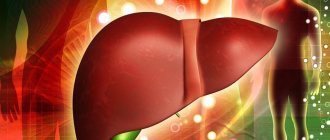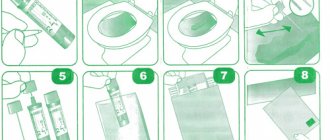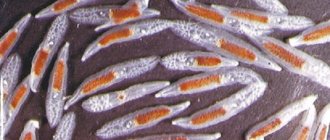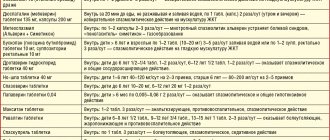Symptoms in children and adults.
Symptoms of infection may vary. It depends on the exact form in which the pathology occurs. There are five such forms:
- gastrointestinal;
- typhus-like;
- asymptomatic;
- bacterial carriage;
- septic.
Depending on the form, the symptoms of salmonellosis manifest themselves differently. However, symptoms have been identified that will indicate that a person has an intestinal infection. In adults, these symptoms include:
- a sharp decrease in pressure;
- cardiopalmus;
- weakness;
- headache;
- abdominal pain;
If the infection has reached the large intestine, blood may be present in the stool.
Children in the first 5 years of life suffer the most from salmonellosis. Because they have extremely low intestinal immunity, but at the same time they actively “drag” food, toys, and various objects into their mouths.
The incubation period for salmonellosis in children can be very short - only a few hours. But usually it is 1-2 days. As a rule, the younger the baby, the faster the disease makes itself felt. The most obvious symptoms of salmonellosis include:
- Nausea.
- Vomit.
- Diarrhea (often with clots of mucus and blood).
- Pain and rumbling in the stomach.
- Fever.
- Dehydration;
Against the background of extreme dehydration - loss of consciousness, loss of orientation, profuse cold sweat, convulsions.
Video: about salmonellosis infection
Read further:
How salmonellosis is transmitted from person to person - routes of transmission
Symptoms of E. coli poisoning in children and adults
10 ways to strengthen your immune system
The most complete list of necessities for a newborn
How to start a new life without alcohol
Article rating:
( 1 ratings, average: 5.00 out of 5)
Share with friends:
You may also be interested in:
Diet for salmonellosis in adults and children: list of recipes
Salmonellosis in quail and chicken eggs - how to recognize
Does it make sense to treat rotavirus with Coca-Cola?
Green stool: what does it mean?
Causes of occurrence.
The causative agent of salmonellosis is excreted in feces, after which it enters the body through the oral cavity. Most often, bacteria affect the stomach and small intestine.
After salmonella manage to penetrate the gastrointestinal tract, they end up in the small intestine. Together with particles of epithelium, they reach the mucous membrane, where bacteria begin to multiply. The waste products of the pathogen are toxic to the human body. Then the transport of ions begins and a sharp withdrawal of electrolytes and water from the body’s cells into the intestines occurs.
The sources of salmonella can be not only infected people. Poultry, pigs, cattle and domestic animals can carry the infection.
There are several main routes of transmission and infection of the human body. The most common ones are:
- Fecal-oral. A person becomes infected by eating food contaminated with the bacteria.
- Swimming in ponds or pools contaminated with salmonella can also lead to this.
- Drinking raw water.
- You can become infected with salmonellosis even with an ordinary handshake.
- And also, when using other people's personal hygiene items.
Ways of infection with salmonellosis
As mentioned above, salmonella is a very stable and protected type of microorganism.
Salmonella actively move due to the presence of flagella , withstand low temperatures up to complete freezing, and multiply quickly in any nutrient media (including milk, meat).
They can exist in isolation for up to 120 days, and when in feces - up to 4 years, they die only when boiled (within 2-3 minutes) or with prolonged exposure to high temperatures (sometimes up to several hours).
Ways of transmission of salmonellosis:
- Nutritional . The predominant route of transmission of salmonellosis is through food and products via the fecal-oral mechanism. As modern statistics show, up to 80 percent of all diagnosed cases of salmonellosis occur through the nutritional route of transmission,
- Contact and household . Alternative route of infection, accounting for up to 15 percent of all reported infections,
- Water and air-dust . The epidemiological significance is small - only up to 5 percent of salmonellosis cases. Both routes are indirect and can act as an obvious mechanism of infection only in the presence of special conditions and additional provoking factors.
Alimentary route of infection
Infection with salmonellosis is most often possible through transmission of salmonella through food. At the same time, manifest forms of infectious disease also play an important role here - for example, a person’s predisposition to bacterial infection due to weak immunity, the gradual accumulation and proliferation of salmonella in products, etc.
At particular risk are children, the elderly, patients who have undergone surgery, patients with malignant tumors, those with AIDS, workers on farms and poultry farms, as well as individuals who are fond of raw materials and do not attach much importance to personal hygiene standards.
The most common sources of salmonellosis infection through the alimentary route of transmission are meat, fish, eggs, dairy products, as well as any dishes with insufficient heat treatment, including salads made from raw vegetables and fruits.
It’s quite easy to get infected from food – you just need to eat it.
If the concentration of salmonellae that have penetrated into the body is sufficient for the formation and development of a colony of these microorganisms, then after the incubation period has expired (usually up to 1 day), a person will feel the first signs of the disease caused by the systemic influence of entero-, cyto- and endotoxins - the former disrupt the functioning of the gastrointestinal tract, the latter destroy cellular structures through inhibition of protein synthesis, while others are released as the final product of the decomposition of Salmonella.
Contact and household
The second alternative route of transmission of salmonellosis is most often caused by a person being near infected pets and farm animals - cows, sheep, pigs. Less commonly, rodents act as carriers.
Among wild fauna, carriers can include wolves, bears, arctic foxes, foxes, beavers and birds - mainly waterfowl.
The contact and household route of transmission in the case of salmonellosis is based on the release of bacteria through saliva, nasal mucus, urine and feces of bacteria carriers, which significantly increases the risk of potential infection among agricultural workers and people serving domestic animals, even in the absence of obvious symptoms of the disease in the latter.
Why is salmonellosis dangerous?
Delayed or incorrect therapy can lead to the following complications:
- heart and kidney failure;
- sudden jumps in blood pressure;
- respiratory arrest;
- from the internal organs - the formation of purulent deposits;
- peritonitis;
- appendicitis;
- arthritis;
— infectious-toxic shock;
- exacerbation of chronic diseases (pancreatitis and cholecystitis).
Bacteria survival
Salmonella are quite resistant to survival in the environment. In food products such as milk, butter, eggs, salmonella remain active for a long time, even if the products are stored in the refrigerator. Salmonella can multiply in infected meat even when smoked and salted.
Article on the topic
Raw and dangerous. What foods can give you parasites?
So storing food in the refrigerator is right and true, but it will not protect against salmonellosis infection if an infected product is eaten. Moreover, low temperatures are favorable for salmonella.
But high temperatures, on the contrary, are dangerous. At a temperature of 100 degrees C, the death of the pathogen occurs.
Interestingly, salmonella, being in food products, does not change their taste, which means it is impossible to determine “by heart” whether a product is infected or not.
What is salmonella?
Salmonella are gram-negative rod-shaped microorganisms that can cause salmonellosis, a diarrheal disease in humans.
Gram-negative bacteria usually have a cell wall consisting of a thin layer of peptidoglycan covered by a membrane.
There are more than 2,300 subtypes of Salmonella enterica, including serovars enterititis, Salmonella Agbeni, and typhimurium.
The bacteria live in the intestines of infected people and animals. Some strains can cause disease in animals and humans.
Salmonella is the leading cause of human bacterial infections in the United States. Salmonellosis affects approximately 1 million Americans each year and results in 19,000 hospitalizations and 380 deaths, according to the Centers for Disease Control and Prevention (CDC).
Causes of salmonellosis
Salmonellosis can be caused by raw meat or seafood.
Salmonella lives in the intestines of birds, animals and humans. Most infections in humans are caused by eating food or drinking water that has been contaminated with feces.
The most common food sources of infection:
- Raw meat, seafood and poultry:
Contamination most often occurs during the slaughtering process. Harvesting seafood from polluted waters is also a common cause. - Raw eggs:
Eggs from an infected chicken may also contain bacteria. The US Food and Drug Administration (FDA) estimates that there are 79,000 cases of foodborne illnesses associated with eating Salmonella-containing eggs each year in the United States. Raw eggs are found in some types of mayonnaise and homemade sauces. - Fruits and vegetables:
They can become contaminated after being watered or washed in contaminated water. Fruits and vegetables can also become contaminated if you cook raw meat and then handle the fruit without washing your hands.
Preventive actions
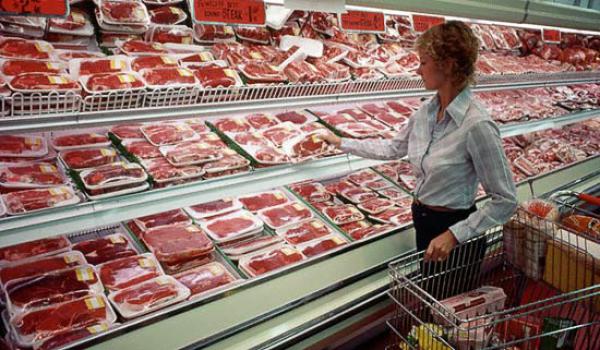
People can protect themselves from acute intestinal infections in the following ways:
- products must be purchased only from trusted retail outlets;
- in the process of preparing dishes, it is necessary to follow all technologies;
- Tap water must be boiled;
- personal hygiene standards should be observed;
- You should not swim in bodies of water near which waterfowl live, or from which cattle drink water;
- It is extremely important to follow food storage rules, etc.
People are scratching their heads over the transmission of salmonellosis. The route of transmission from animals to humans has long been described, but the number of patients is not decreasing. The incubation period is short. It is possible to determine the source of infection based on medical history. The incidence is growing every year. Scientists are trying to invent a vaccine against the disease. In Africans, the bacillus is layered with other infections - the mortality rate for salmonellosis is significant.
The microbe is killed during pasteurization. Problems arise with chicken eggs - no disinfection measures are taken for them. You can become infected with salmonellosis by eating scrambled eggs. This is the main reason for the spread of epidemics in the United States. Israeli owners of public food establishments post a warning at the entrance that fried egg lovers take the risk of infection upon themselves.
Symptoms of salmonellosis
There are thousands of subtypes of Salmonella, but only 12 of them can cause disease in humans, usually gastroenteritis.
Signs and symptoms of Salmonella gastroenteritis:
- spasmodic pain in the stomach
- bloody stool
- chills
- diarrhea
- fever
- headache
- muscle pain
- nausea
- vomit
- dizziness
Some people complain of joint pain - this is known as reactive arthritis. It can persist for months or years and can develop into chronic arthritis.
Treatment of salmonella infection
Symptoms of Salmonella gastroenteritis usually go away without treatment in about a week.
Fluids: The patient should drink plenty of fluids to prevent dehydration.
Antibiotics: These may not help for uncomplicated gastroenteritis. A doctor may prescribe them if symptoms are severe or bacteria have entered or are likely to enter the bloodstream. The use of antibiotics can lead to antibiotic resistance and the risk of recurrent infection.
Antidiarrheal medications: These can stop diarrhea. They reduce cramping pain, but may cause diarrhea to last longer.
